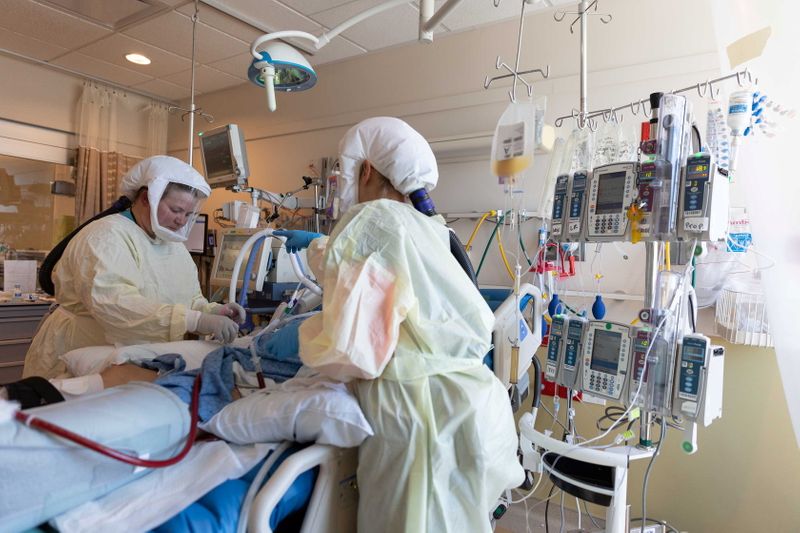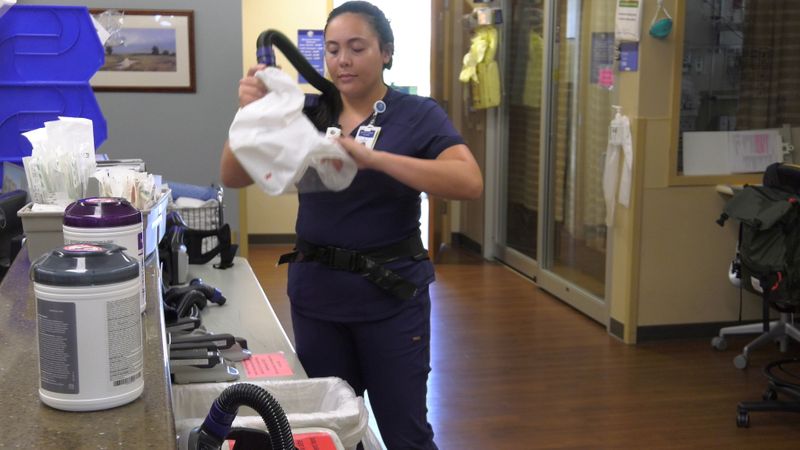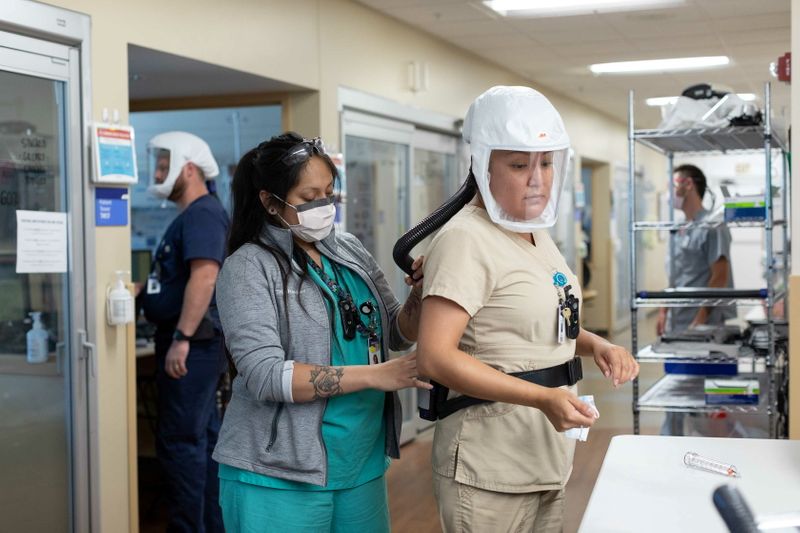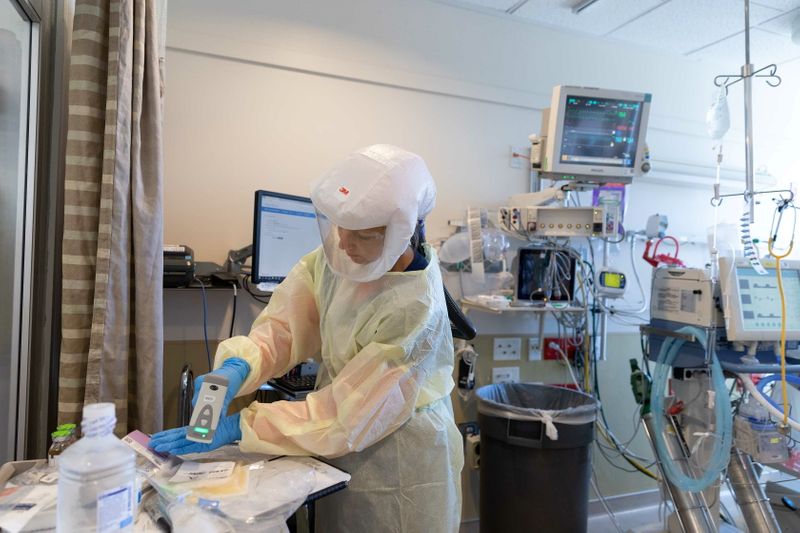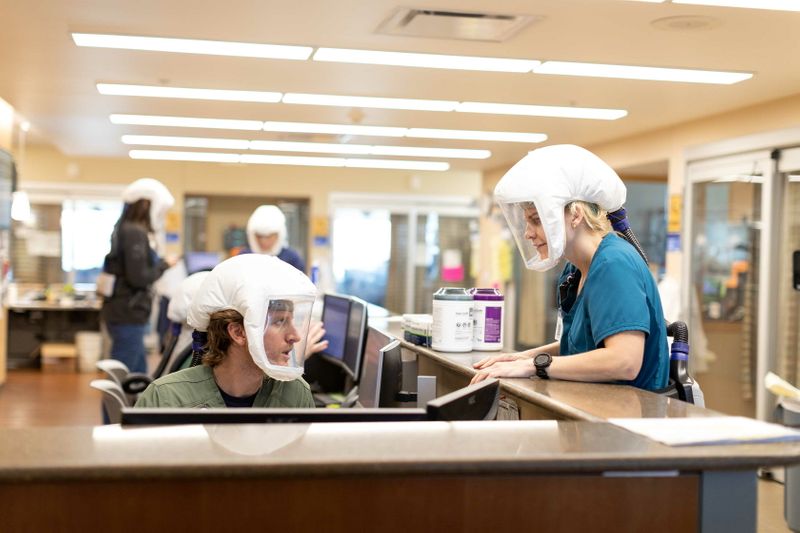(Reuters) – The COVID-19 intensive care unit where nurse Janine Roberts works in a Salt Lake City suburb is once again full, with patients who are mostly young, mostly unvaccinated and very ill.
They arrive in the unit at Intermountain Medical Center in Murray, Utah, already intubated and unconscious, in many cases stricken by the Delta variant of the coronavirus blazing through unvaccinated communities across the United States.
“We have people in their 20s, 30s, even 40s who are so desperately sick, and we’re seeing all patients who are unvaccinated,” Roberts said. “It’s this new terrain.”
Healthcare providers like Roberts had expected the rollout of COVID-19 vaccines to curb hospitalizations. But just 45% of Utah residents are fully vaccinated against COVID-19, and their vulnerability is fueling a surge in the virus, state data shows.
Utah’s intensive care units were 84% full on July 22, and COVID patients made up about a quarter of the population. By comparison, the units were 59% full on April 19, and only 11% of those patients had COVID, state data shows.
The quick rise in coronavirus transmission and hospitalization in Utah and many other states serves as a reminder that the country is still in the throes of a deadly disease, even as signs of pre-pandemic life have returned with people flocking back to restaurants, concerts and summer camps.
The Delta variant is far more contagious than earlier versions of the coronavirus, enabling it to pass quickly among unvaccinated people, many of whom are young adults. Its fast spread has quickly overwhelmed health systems in the United States, which in previous surges led to less effective care and more deaths.
To make room for COVID-19 patients, the University of Utah Hospital in Salt Lake City has begun postponing non-essential surgeries, said Dr. Kencee Graves, its associate chief medical officer.
The hospital’s total COVID case load is lower than last winter, she said, but tight staffing and an influx of non-COVID cases have left it just as strained.
The unwillingness of so many people to get vaccinated adds to the frustration, she said.
“Caring for someone during the first surge, when this was not a wholly preventable illness was one thing,” Graves said. “Now this is totally preventable. It’s demoralizing.”
STATE LIMITS RESTRICTIONS
Of 247 deaths in Salt Lake County from the beginning of this year through July 9, 99% were among unvaccinated people, said Ilene Risk, the county’s top epidemiologist. Transmission in the county is particularly high in zip codes where fewer people are vaccinated.
Utah’s Republican-controlled legislature has banned local jurisdictions from imposing COVID-19-related restrictions, leaving public health officials no way to slow the spread of infection, said Dr. Todd Vento, an infectious disease specialist with Intermountain Healthcare, a large healthcare provider.
Local school districts are also banned from requiring children and teachers to wear masks.
“You’re just watching it like a train crash in slow motion,” he said.
Vento said one of his patients who refused to get vaccinated died from the virus, leaving behind a spouse and young children.
Hospital admissions among children have jumped in recent weeks, said Dr. Andrew Pavia, a pediatrician in the Salt Lake City area. Unlike prior surges, many do not have underlying conditions to make them more vulnerable to COVID, he said.
While speaking with a reporter late last week, Pavia’s cellphone beeped with a text message from colleagues telling him that an 11-month-old infant in a part of the state with low vaccination rates had been admitted and put on oxygen.
Nancy Foster, vice president of the American Hospital Association, said wards throughout the country are crowded with COVID-19 patients as well as people who put off care during the pandemic. Doctors and nurses have left hospital jobs for other work, and providers who might have been willing to travel to help out in hard-hit areas are needed at home, she said.
“After 18 months of COVID, health care workers who have given so much of themselves to care for people are exhausted,” she said. “They are burned out.”
The Utah Nurses Association is developing online stress management classes to help caregivers cope, said Executive Director Liz Close.
At Intermountain Medical Center, Roberts said she and some of her team think about quitting daily.
“I’ve had so many people coming to me saying, ‘This is so, so hard,'” she said.
The nice gestures people did for healthcare providers early in the pandemic – help with laundry or a free meal – have stopped. Some patient’s relatives, particularly those whose political beliefs have led them to reject COVID vaccines and doubt the medical establishment, can be unkind, she said.
Too late, some people have come to the realization that they or their family members should have gotten vaccinated. Roberts said the hospital received one letter from a COVID-19 patient who eventually recovered enough to be sent home.
In it, the patient wrote: “I wish I could take back everything I believed and everything I said about this.”
(Reporting by Sharon Bernstein; Editing by Colleen Jenkins and Steve Orlofsky)

